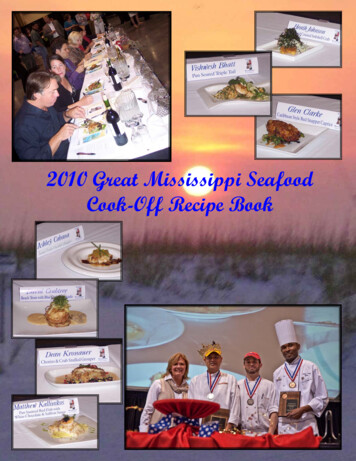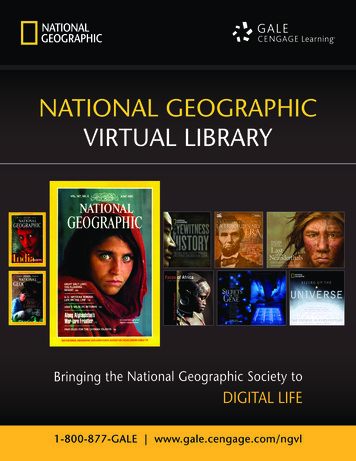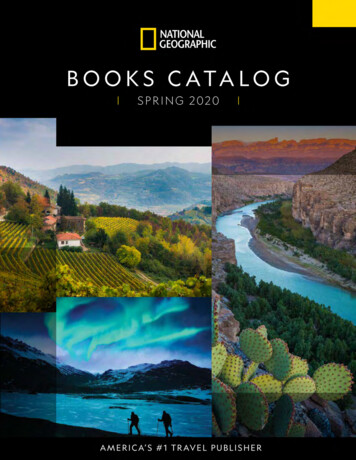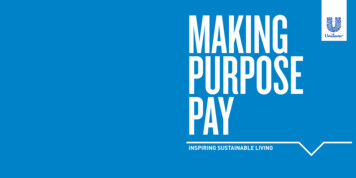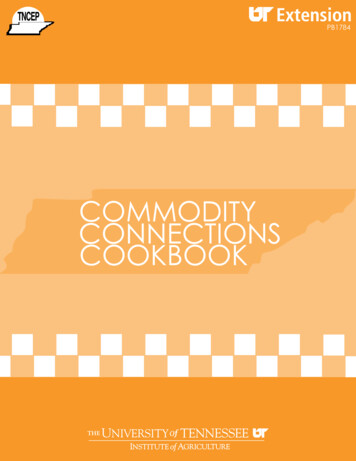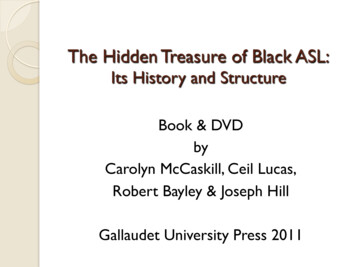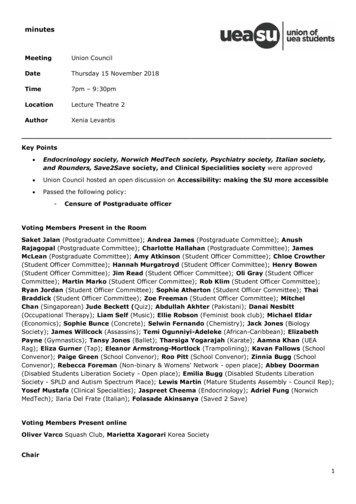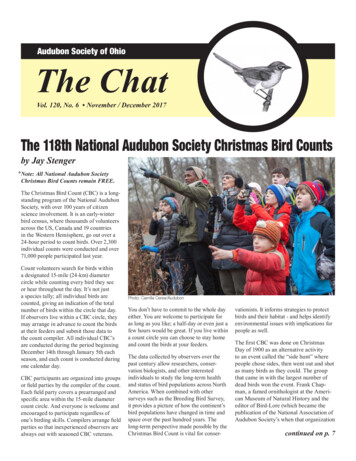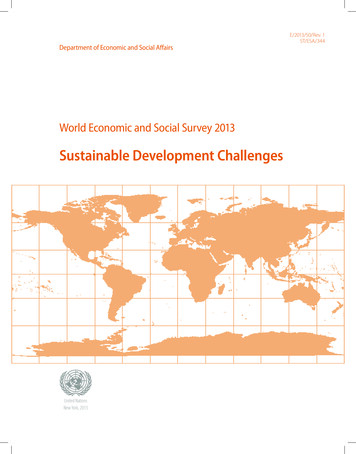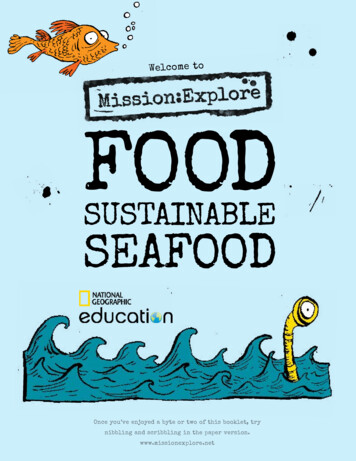
Transcription
Welcome toFOODSUSTAINABLESEAFOODOnce you’ve enjoyed a byte or two of this booklet, trynibbling and scribbling in the paper version.www.missionexplore.net
DOOFAESELBANIATSSUDear Educator,We have always been dependent on the world ocean for our survival. Even thoseof us in the centre of the world’s largest continents depend on the Earth’slargest bodies of water, if not for trade, culture, or food, then for the vitalrole they play in our weather and climate.By completing the missions in this booklet your students will rethink theirrelationship with the world ocean through the seafood they eat. Do not go anyfurther if you are afraid of going on adventures or tasting new things.This is a special “seafood” version of Mission:Explore Food (a big book of 159missions) and inside you will find 20 seafood-related missions—some havebeen adapted and some are written specially for this booklet. Each missionwill help your students think differently about their relationship with notonly seafood but also the ocean, people, places and systems that they areconnected to.The challenge is for (you and) your students to complete and record themission-based learning activities that you’ll find on the following pages.Each of the illustrated activities that you find in this booklet areappropriate for learners of all ages, but younger learners will need moresupport to get going, and we’re sure you’ll be expecting much moresophisticated responses from more advanced students. This is a CreativeCommons publication, so feel free to copy and use each of the missions howeveryou want.With your help, by the time your students have completed their unique copy ofthis booklet they will have a deeper understanding of their interdependencewith all things seafood. They’ll also develop their creative and critical skillsin extreme exploration, guerrilla geography,and munching on tasty stuff.It’s time to explore.The Geography Collective2
DOOFAESELBANIATSUSDear Explorer,This booklet will change the way you see seafood forever. Reading further willresult in going on adventures, taking risks and trying new things.The world ocean is beautiful, but it is also critical to our survival. Ourweather and climate is shaped by it. It contains vital global ecosystems. Oureconomies rely on it, and it is a source of food for billions of people aroundthe world. Our lives depend on the world ocean.Overfishing, climate change, and pollution are all having devastating effectson sea life around the world. Seafood supplies are under threat. Millions ofpeople’s jobs are at risk and many species of fish are on the brink ofextinction.It’s not all bad news though. There are many success stories of efforts toprotect sea life and the livelihoods of people who depend on it. You too havethe power to protect the ocean. We are all connected to our world ocean, andby exploring and understanding these connections we can take action torestore it.Inside this special Mission:Explore Seafood booklet you will find 20 seafoodrelated missions. Each mission explores seafood in a different way and revealshow you are connected to the ocean. Your challenge is to complete each missionas best you can.By the time you have completed your unique copy of this bookletyou will be an extreme explorer, guerrilla geographer, oceanactivist, and 100% edible.Do make sure that you have permission before attempting anymission from this booklet, and remember, the more you putin the more you’ll get out.It’s time to explore.The Geography Collective3
Pages from Mission:Explore Food www.missionexplore.netThere are lots more fish that you could add to your chart.Visit the Marine Stewardship Council website to work outwhich fish are safe for you to eat. www.msc.orgComplete this identification chart to help you avoid munching onthese increasingly rare sea creatures.Some species of fish are being caught, or harvested, and eaten soquickly that their numbers are going down. Many are endangeredand even face possible extinction because we’re overharvestingthem.MESF001Don’t bite endangered fish4
Draw lines from where you live to where your seafood comes from.Where in the world don’t you get seafood from?MESF002Spot where you don’t get seafoodPages from Mission:Explore Food www.missionexplore.net5
GrouperSquidSquirrelElephantPigeonAnacondaFlying hinWhaleCrabCrocodileDogPages from Mission:Explore Food tulaRed SnapperAll of the animals below are eaten somewhere in the world. Which ofthese animals do you think it’s good to kill and eat, bad to killand eat, or somewhere in between? Draw them on the line in anorder of your choice.All animals in the world can be hunted, harvested, and eaten. Thatincludes you.MESF003Good huntingBadGood6
MESF004Traffic light your seafoodEverything you buy has an effect on someone, something, andsomewhere. At stores these effects are mostly hidden.Investigate how your seafood affects other people, wildlife, andplaces by discovering the answers to these questions. Keep a trafficlight record of your findings after asking the questions below. Were the people involved in your seafood given a living wage?Were any creatures treated well?Is your seafood sustainably harvested?Was it transported a reasonable distance?Was the place it came from treated well?Green GoodYellow SatisfatoryRed BadAs a guerrilla geographer you should ask questions likethese to help you decide if you will buy a product or not.Labels can often help, but sometimes you need to do your owninvestigations.Pages from Mission:Explore Food www.missionexplore.net7
MESF005Go fishingAdd something fishy here.Pages from Mission:Explore Food www.missionexplore.net8
MESF006Watch another animal harvest seafoodSketch it here.Pages from Mission:Explore Food www.missionexplore.net9
MESF007Hold an overharvest festivalPeople on Earth are harvesting fish, trees, fertile soil, and otherresources more quickly than they can reproduce, regrow, andreplenish. If we don’t become smarter about what, where, when, how,and how much we harvest, we’ll endanger the lives of creatures andcommunities around the world. To raise awareness of this issue,hold an overharvest festival.Use this planner to help you organize your event. Event name Date Overharvested foods to celebrate Games Performances This mission is about living sustainably and finding abalance. You could invent games to play where contestantsmust balance in some way or avoid going too far.Pages from Mission:Explore Food www.missionexplore.net10
MESF008Innovate with seaweedHow many different things can you use seaweed for? Keep a list ofyour inventions.Pages from Mission:Explore Food www.missonexplore.net11
MESF009Delicious dilemmasChoose which one you think is better to eat. Why?garlic for a weeksprouts for a weekfarmed fishwild fishlocal foodfair trade foodenvironmentally friendly foodpeople friendly foodmeatplantschocolatepotato chips1 endangered fish100 not endangered fishanythingeverythingsealdolphinWhen you research this mission remember that the answer maynot be straightforward. Consider advantages, disadvantages,and likely outcomes for each delicious dilemma.Pages from Mission:Explore Food www.missionexplore.net12
MESF010Cook in acidMake ceviche, a South American dish that’s “cooked” in citrusjuice. Try dipping tortilla chips in this vegetarian version, orchunk it up with some very fresh sustainable fish.4 or more limes1 medium onion2 tomatoes¼ cucumberTortilla chips, to serve1. Chop the onion finely andplace in a mixing bowl. Chopeverything else into piecessmall enough to fit 3 or 4 ona single tortilla chip.3. Squeeze the lime juiceover your vegetables so thatthey are completely covered.5. Give it a final stir thenserve with the tortillas.Extras:Sweet or chilli pepperCorianderMushroomsFish, squid, crab or even lobster2. Put any waste in yourcompost.4. Cover and leave in thefridge for 3 to 4 hours. Theacid in the lime will slowly‘cook’ the vegetables and fish.Serving suggestion: enjoy on a beach at sunset.WARNING!Normal heating processes usually prevent fish from makingpeople sick. Seafood ‘cooked’ in this way can be poisonous.Make sure that any seafood you use is very fresh.Pages from Mission:Explore Food www.missionexplore.net13
Pages from Mission:Explore Food www.missionexplore.netWhere in the world aren’t your recipesfrom? Color in the origins of yourcooking until the whole of thismap is covered.MESF0011Map your seafood recipes14
MESF012Design a sustainable seafood menuCreate a three-course menu using seafood that’s good for the tastebuds, mind, body, and environment.Design your dishes so they: are tasty; are healthy;are fair and friendly for the growers;are as friendly as possible to creatures and plants;have ingredients that have travelled to you sustainably;and need the least amount of energy to be cooked.Plan your menu below. Can you persuade a local restaurant to stockyour inventions?Pages from Mission:Explore Food www.missionexplore.net15
MESF013Alien attackDefend your local coastline against alien invaders that aredamaging your local ecosystem. Research, hunt down, catch, cook,and eat sea animals or plants that have invaded beaches, rock pools,or local waters. Check out www.eattheinvaders.org for tips.Keep count of the aliens you’ve personally digested here:Pages from Mission:Explore Food www.missionexplore.net16
MESF014Draw a cooking treeCreate a family tree and collect a recipe that uses seafood fromeach person in it. You may even be able to get recipes that wereused by people who have now died if you ask the right people theright questions.Draw your tree here.Pages from Mission:Explore Food www.missionexplore.net17
MESF015Cook your seafood BoilingBlanchingBraisingInfusingPoachingPressure -fryingSmokingPages from Mission:Explore Food www.missionexplore.net18
MESF016Capture a crustaceanSay hello to your catch, then issue themwith an official reprieve beforesetting them free.List your reasons here:1.2.3.WARNING!Get permission for this mission: you might need alicense. Only release creatures into the place youfound them or they might end up damaging habitats.Pages from Mission:Explore Food www.missonexplore.net19
/10 Easy?/10/10/10/10/10Nutritious?Friendly?/10 Easy?/10/10/10 Delicious? No meat, but seafood is allowed/10 Easy?/10 Delicious?PescatarianNutritious?Friendly?/10/10 Easy?/10/10/10 Delicious?/10 Easy?Nutritious?Friendly?/10 Easy?/10/10/10 Delicious? No meat, except kangaroo/10/10/10 Delicious?KangatarianNutritious?Friendly? Only eat kosher food that is allowed by the laws of Halakha No carnivorous mammals No mammals that either don’t chew the cud or have clovenhooves No birds of prey, reptiles, or water animals without fins andscalesKashrutNutritious?Friendly? No meat, fish, or animal products, including eggs, milk, andhoney/10 Easy?Pages from Mission:Explore Food www.missionexplore.net Only fruit, nuts and seeds that have fallen naturally from aplant without killing or harming it/10 Easy?/10 Delicious?FruitarianNutritious?Friendly? Only eat natural, unprocessed food Avoid meat and don’t eat pork Avoid fish over 12 inches in lengthItalNutritious?20Vegan/10Friendly?/10 Delicious?Nutritious? No meat No animal ingredients including gelatin/10Friendly?Vegetarian/10 Delicious?Dhabihah. No eating of pork, blood or found animals Only eat food that is allowed under Islamic Law. Most animalsother than fish must be slaughtered using a method calledHalalTry these different diets. Which do you think is best?MESF017Experiment with diets
MESF018Ditch your packagingFood packaging is floating around the world ocean, infiltratingthe food chain and harming many sea creatures. Encouragesupermarkets to use less packaging by asking to leave all the bitsyou don’t need at the cash register before taking your food home.Keep a diary of how people respond to your actions here.Some supermarkets encourage customers to do this so theycan understand how to reduce their packaging costs.Pages from Mission:Explore Food www.missionexplore.net21
MEOC019Smells fishyMake this page smell of the seaside by filling each of these circleswith different fishy scents.Pages from Mission:Explore Food www.missionexplore.net22
MEOC020Explore like a .SharkDolphinSeahorseSquidSea StarSalmonManateeSealFlying FishManta RaySea SnakePenguinPages from Mission:Explore Food www.missionexplore.net23
This is a special "seafood" version of Mission:Explore Food (a big book of 159 missions) and inside you will find 20 seafood-related missions—some have been adapted and some are written specially for this booklet. Each mission . buds, mind, body, and environment. Design your dishes so they: are tasty; are healthy;
